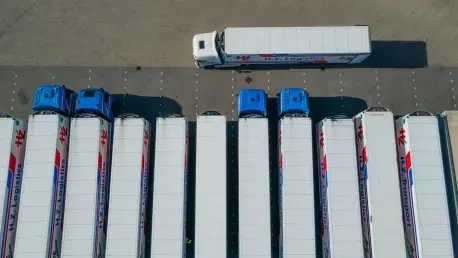Imagine a world where fleet managers can pinpoint the exact location of every vehicle, monitor driver behavior in real time, and predict maintenance needs before a breakdown occurs—all from a single dashboard. This isn’t a distant dream but the reality brought by telematics, a powerful fusion of telecommunications and informatics that’s transforming fleet management. Once a supplementary tool, telematics has become a vital component for industries like trucking, last-mile delivery, and electric vehicle operations. It’s not just about tracking; it’s about unlocking efficiency, slashing costs, and enhancing safety while meeting ever-growing customer expectations. This article dives into how this technology is reshaping the landscape, tackling critical challenges, and paving the way for a more connected and sustainable future in transportation.
The impact of telematics is staggering, with the commercial market expected to surge from its current value to $64 billion by 2030, reflecting a robust annual growth rate of 14.3%, as reported by Allied Market Research. This explosive trajectory highlights a shift in perception—telematics is no longer a mere experiment but a strategic priority for business leaders. Companies across various sectors are leveraging this technology to gain real-time visibility into their assets, ensuring smoother operations and stronger compliance with regulations. From reducing fuel consumption to optimizing delivery routes, the benefits are clear, positioning telematics as an indispensable ally in a competitive, data-driven environment.
The Core of Telematics: Transforming Fleet Operations
Redefining Visibility and Efficiency
Telematics offers fleet managers an unprecedented level of insight by delivering up-to-the-minute data on vehicle locations, driver performance, and equipment conditions. This real-time information allows for swift decision-making, such as rerouting vehicles to avoid traffic delays or identifying underutilized assets for better allocation. Beyond just tracking, the technology helps in spotting patterns—like excessive idling—that drain resources, enabling proactive measures to enhance productivity. The ability to monitor every aspect of a fleet from a centralized platform not only reduces operational downtime but also fosters a more agile response to unexpected challenges, ensuring that businesses remain adaptable in dynamic markets.
Another critical advantage lies in the cost savings and regulatory benefits telematics brings to the table. By analyzing data on fuel usage and route efficiency, companies can significantly cut expenses, often seeing immediate returns on their investment in the technology. Additionally, telematics ensures adherence to stringent industry regulations by providing detailed logs of driver hours and vehicle maintenance schedules, minimizing the risk of fines or penalties. This dual focus on cost reduction and compliance transforms telematics into a cornerstone of operational success, particularly for industries under constant scrutiny, such as long-haul trucking and urban delivery services, where precision and accountability are paramount.
Enhancing Safety and Customer Trust
A pivotal aspect of telematics is its role in bolstering safety across fleet operations through detailed monitoring of driver behavior. By tracking metrics like speeding, harsh braking, or erratic maneuvers, managers can identify risky patterns and implement targeted training programs to mitigate accidents. This not only protects drivers and assets but also reduces liability costs associated with collisions. Safety improvements driven by telematics data contribute to a culture of responsibility, ensuring that fleets operate with the highest standards of care on every journey, ultimately safeguarding public trust in their services.
Equally important is how telematics elevates customer satisfaction by providing transparency and reliability in service delivery. Real-time updates on vehicle locations enable precise delivery estimates, keeping clients informed and reducing frustration over delays. Moreover, the data collected helps in verifying service completion, which is crucial for billing accuracy and dispute resolution. For businesses reliant on last-mile delivery, this level of clarity builds stronger relationships with customers, positioning companies as dependable partners in an era where expectations for speed and accuracy continue to rise.
Overcoming Barriers: Challenges and Solutions
Scaling with Seamless Connectivity
Scaling telematics systems to manage large fleets often reveals significant connectivity challenges, especially in remote areas or environments like tunnels where signals falter. These coverage gaps can create data blind spots, disrupting audits and eroding confidence among stakeholders who rely on consistent updates. To counter this, hybrid connectivity solutions that integrate satellite, Wi-Fi, and cellular networks have emerged as a game-changer. Paired with local data storage for delayed transmission, these tools ensure that no critical information is lost, providing fleet managers with a complete picture of operations even in the most challenging terrains, thus maintaining trust and operational integrity.
Beyond connectivity, the complexity of managing thousands of devices poses a logistical hurdle that can slow down expansion. Manual provisioning and fragmented hardware setups often lead to inefficiencies and inflated costs. However, innovations like cloud-native device management and eSIM/iSIM technologies offer a streamlined approach by enabling automatic configuration across diverse global networks. Such advancements simplify the transition from small-scale pilots to fleets of 50,000 units or more, cutting down on both time and expense. This seamless scalability ensures that growth doesn’t come at the cost of control, allowing companies to expand with confidence and efficiency.
Securing Data in a Connected World
As telematics systems handle sensitive data—ranging from driver habits to customer route histories—cybersecurity risks loom large, with each connected device representing a potential vulnerability. A single breach can compromise not just operational data but also client trust, making robust protection non-negotiable. Hardware-based security solutions, such as dedicated chipsets with encrypted storage and tamper resistance, provide a strong defense against threats. These measures ensure that data remains secure even if a device is physically accessed, offering peace of mind to fleet operators managing vast networks where every endpoint must be safeguarded against evolving digital dangers.
Maintaining security across large-scale deployments also requires efficient update mechanisms to address vulnerabilities without disrupting operations. Real-world examples, like New York City’s monitoring of over 27,000 municipal vehicles through a centralized system, demonstrate how secure, scalable implementations can balance protection with continuity. By leveraging hardware that supports remote firmware updates and standardized security protocols, fleets can stay ahead of threats without the need for costly manual interventions. This approach not only protects data but also ensures that security enhancements are applied uniformly, maintaining operational flow even as cyber risks grow more sophisticated.
Future-Proofing Fleets: Innovation and Sustainability
Power Efficiency and Precision Tracking
With the rise of electric vehicle fleets, power efficiency in telematics systems has become a critical focus to preserve battery life without compromising functionality. Modern designs prioritize low-power consumption by using intelligent filtering to activate modems only during significant events, such as accidents or route deviations, while minimizing unnecessary alerts. This targeted approach reduces energy drain, ensuring that electric vehicles can operate longer between charges, which is vital for cost-effective fleet management. Such innovations reflect a broader commitment to sustainability, aligning telematics with the environmental goals of modern transportation industries striving to reduce their carbon footprint.
Another leap forward is the precision in location tracking, driven by advancements in sensor fusion and GNSS technology, which integrate multiple data sources for lane-level accuracy. This high-precision capability, often achieving 1-meter accuracy without additional processors, is essential for applications like billing verification, safety audits, and delivery confirmation. By providing exact data on vehicle positions, telematics enhances service quality, ensuring that fleets can meet stringent demands for reliability. This level of detail not only boosts operational confidence but also supports customer satisfaction by guaranteeing accuracy in every transaction or interaction.
Building Resilient Infrastructure for Tomorrow
Looking ahead, telematics is being redefined as a core infrastructure layer rather than a mere feature, requiring systems designed for durability over a decade or more. This shift demands foresight in planning for real-world conditions, such as fluctuating network coverage or evolving regulatory standards, to ensure long-term reliability. Fleets must adopt platforms that support autonomous device operation and seamless firmware updates, minimizing downtime and maintaining performance. Such resilience positions companies to adapt to the changing transportation landscape, where digital transformation is no longer optional but a competitive necessity for staying relevant.
Reflecting on the journey, the strides made in telematics have already begun addressing past challenges by integrating hybrid connectivity, robust security, and energy-efficient designs. The focus then shifted toward actionable steps for the future, such as investing in scalable platforms that could withstand emerging cybersecurity threats and support sustainable practices. By prioritizing adaptable, secure systems, fleet operators found themselves better equipped to lead in a data-driven era, ensuring not just survival but innovation in an increasingly connected world of transportation.









